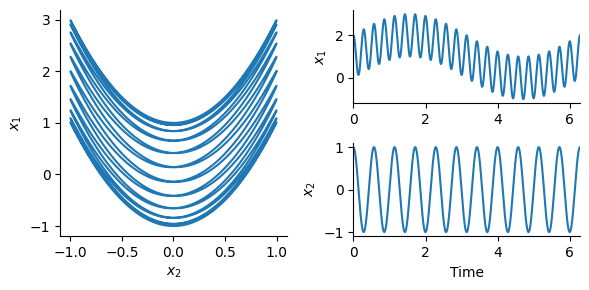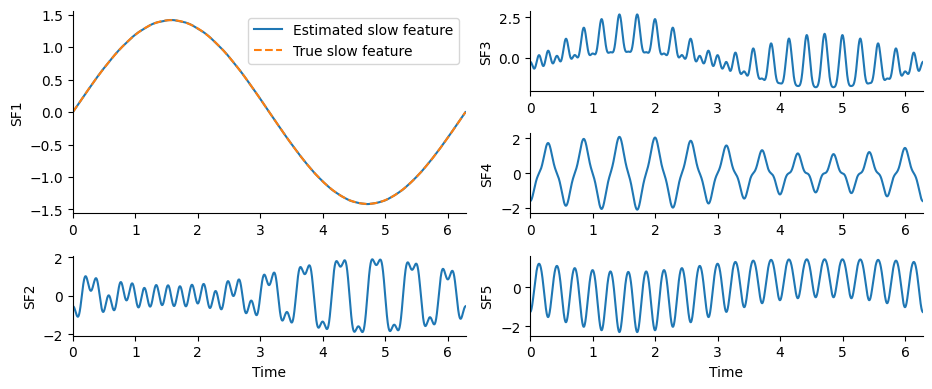Slow Feature Analysis (SFA)
Contents
Slow Feature Analysis (SFA)#
Slow Feature Analysis (SFA) とは, 複数の時系列データの中から低速に変化する成分 (slow feature) を抽出する教師なし学習のアルゴリズムである (Laurenz Wiskott, Berkes, Franzius, Sprekeler, & Wilbert, 2011; L. Wiskott & Sejnowski, 2002).
潜在変数 \(y\) の時間変化の2乗である \(\left(\frac{dy}{dt}\right)^2\)を最小にするように教師なし学習を行う.初期視覚野の受容野や格子細胞・場所細胞などのモデルに応用がされている (Franzius, Sprekeler, & Wiskott, 2007).
生理学的妥当性についてはいくつかの検討がされている.(Sprekeler, Michaelis, & Wiskott, 2007)ではSTDP則によりSFAが実現できることを報告している.ただし,in vivoにおけるSTDPの存在については近年疑問視されている.これまでのin vitroでの実験は細胞外Ca濃度が高かったために、pre/postのスパイクの時間差でLTD/LTPが生じるという「古典的STDP則」が生じていた可能性があり,細胞外Ca濃度をin vivoの水準まで下げると古典的STDP則は起こらないという報告がある (Inglebert, Aljadeff, Brunel, & Debanne, 2020).古典的な線形Recurrent neural networkでの実装も提案されている (Lipshutz, Windolf, Golkar, & Chklovskii, 2020).
using PyPlot, Statistics, LinearAlgebra
rc("axes.spines", top=false, right=false)
SFAの前処理#
SFAの前処理として多項式展開(polynomial expandsion)が用いられる (Berkes & Wiskott, 2005).Pythonにおいてはsklearn.preprocessing.PolynomialFeaturesにより使用できる.
monomials(n, d) = [t for t in Base.product(ntuple(i->0:d, Val{n}())...) if sum(t)<=d && sum(t) > 0]
polynomial_expand(X, d) = hcat([[prod(X[i, :] .^ m) for m in monomials(size(X)[2], d)] for i in 1:size(X)[1]]...)'
whiten(X) = (X .- mean(X, dims=1)) ./ std(X, dims=1)
whiten (generic function with 1 method)
時間的にずらして時系列データの次元を増やす前処理も行われる.
time_frames(X, d) = hcat([X[i:end-d+i] for i in 1:d]...)
time_frames (generic function with 1 method)
データセットの生成#
# create the input signal
nt = 5000;
t = range(0, 2π, length=nt)
x1 = sin.(t) + 2*cos.(11*t).^2;
x2 = cos.(11*t);
X = [x1 x2];
figure(figsize=(6, 3))
subplot2grid((2, 2), (0, 0), rowspan=2)
plot(x2, x1)
xlabel(L"$x_2$"); ylabel(L"$x_1$")
subplot2grid((2, 2), (0, 1))
plot(t, x1)
ylabel(L"$x_1$"); xlim(0, 2π)
subplot2grid((2, 2), (1, 1))
plot(t, x2)
xlabel("Time"); ylabel(L"$x_2$"); xlim(0, 2π)
tight_layout()

SFAの実装#
# Linear slow feature analysis
function linsfa(X)
# X ∈ R^(dims x timesteps)
Xw = whiten(X)
_, _, V = svd(diff(Xw, dims=1))
return Xw[1:end-1, :] * V; # V means weight matrix of X to Y
end
linsfa (generic function with 1 method)
実行と結果表示#
Y = linsfa(polynomial_expand(X, 2));
figure(figsize=(14, 4))
subplot2grid((3, 3), (0, 0), rowspan=2)
plot(t[1:end-1], whiten(Y[:, end]), label="Estimated slow feature")
plot(t[1:end-1], whiten(sin.(t[1:end-1])), "--", label="True slow feature")
ylabel("SF1"); xlim(0, 2π); legend(loc="upper right");
for i in 1:4
if i == 1
subplot2grid((3, 3), (2, 0))
xlabel("Time");
else
subplot2grid((3, 3), (i-2, 1))
end
plot(t[1:end-1], whiten(Y[:, end-i]))
ylabel("SF"*string(i+1)); xlim(0, 2π)
end
xlabel("Time")
tight_layout()


